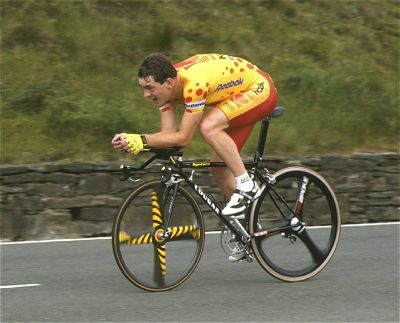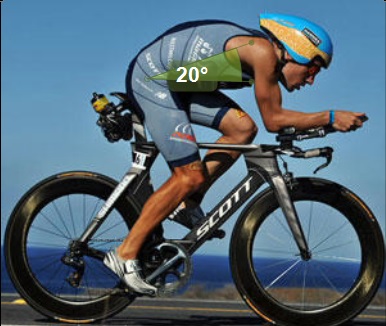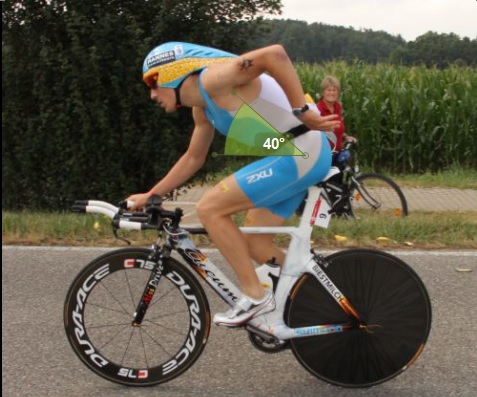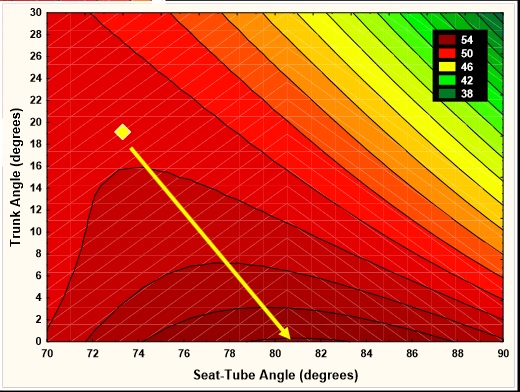The hidden cost of an overly aggressive bike position

Alan Couzens, MS (Sports Science)
Aug 7, 2014
With the 2015 bikes hitting the market, many Ironfolk will be ‘looking to upgrade’. Usually this means better materials, sleeker lines, hiding more ‘stuff’ &, above all else, more aggressive geometry. After all, nothing looks better rolling through transition than a bike with full aero set up and a huge drop. Big drop = low frontal area = this dude is serious about laying down a fast bike split!
Well, there is one element of that equation that is missing – big drop + holding the position for 5ish hours = fast bike split!
While a big drop may look cool coming out of T1, it looks a whole lot less cool when the athlete is sitting up riding the bull horns for the second half of the race. Not only does it look a little ridiculous, it’s also slow. How slow?
When an athlete moves from an aggressive aero position to ‘sitting up’ on the bull horns, he can increase his trunk angle (the angle from the trochanter to the acromion) by 15-20 degrees as shown in the contrasting pics shown below.
Aggressive aero

Sitting up

As this neat chart from one of the experts in the field of bicycle aerodynamics, Professor Daniel Heil, illustrates, this increase in trunk angle can reduce ground speed for a given power output by 10% or more.

In other words, that 5hr split, now becomes a 5:30 split! OK, this may be a little extreme, our athlete is going to want to at least clear the crowds before he starts to sit up ;-), but I would suggest that it is quite common for at least the back half of the mid-front pack bike splits to include a good amount of ‘sitting up’. Based on what I’ve seen, there are a lot of people in that mid-front pack who are leaving 10-15min out there on the course purely because they bit off a little more than they could chew when dialing in their bike fit.
To be fair, it’s not entirely the athlete’s fault, nor is it entirely, the fitter's fault. There is a trickle down effect that comes from pro cycling that ignores the fact that a cycling TT is about 20% of the duration of an Ironman split. In terms of the market, this means that the more expensive bikes, the type ridden by the pro tour teams typically have shorter head tubes that result in a position that borders on intolerable for 180K, at least for ‘Joe Officeworker’.This fact is worth bearing in mind when selecting a new frame. Often the geometry of the ‘one level down’ bikes is far better suited to long course tri than the TT flagship rigs that make up our ‘dream bike’.
To further illustrate with some numbers, typical trunk angles for ‘top notch’ pro cyclists on TT bikes are in the range of 15-20 degrees. Consequently, the geometry of the best TT machines is built around accommodating these positions. Elite long course triathletes, who are more often in the 20-25 degree range can make these frames work, but for the majority of the age-group field – folks who – let’s be honest – might be a little more ‘Tin Man’ than ‘Gumby’, optimal trunk angles, i.e. angles that don’t result in dysfunctional compensation, are often closer to (and sometimes beyond) 30 degrees. The differences here tie in to the natural differences in hip mobility that we see between youngish guys who ride their bike 6hrs a day and your average middle-age office worker that spends 8+ hrs a day with his hips flexed to 90 degrees.
Basically, the spectrum of mobility (especially through the hips/hamstrings) across the gamut of athletes participating in Ironman races is incredibly broad, while the geometry of TT bikes is not. These differences should be accounted for when fitting the athlete/selecting the right bike!
The ‘cost’ of not paying attention to these differences and maxing the hips out is paid by 3 other body parts..
- Back – when hamstrings reach their limit, the back must flex more than it normally would. This leads to increased disc pressure, & excessive tension being placed on the erector muscles of the back which can lead to spasm/cramping, weakness and even muscle strain if prolonged or excessive.
- Neck – Due to the ‘S’ nature of the spine, when the back bends, the neck extends. This leads to problems in looking forward if your extension is already maxed out. It also leads to the neck muscles being perpetually short which can lead to pain & cramping if continued for extended periods.
- ‘Taint’ – When the hamstrings are maxed out, it has the effect of ‘locking the pelvis down’. This literally gives you no ‘wiggle room’. As anyone who has ridden a bike for 100+ miles knows, a little wiggle room to subtly change the pressure point of the saddle is a very good thing! No further detail required!
So, how do we go about identifying our own, individual, 'just right' amount of drop?
A great starting point for identifying just how aggressive your personal position should be comes from a simple hip mobility test called the ‘waiters bow’ explained succinctly in this article/demo from Ironmaven
Using a goniometer measure the most acute angle that you achieve in the test (before lumbar compensation creeps in) and plug that number, along with your body dimensions and your seat angle (angle from BB to actual sit point on the saddle) into the calculator below and it will spit out an approximate trunk angle and a good recommended starting point for your saddle to aero pad vertical drop (negative meaning pads are above saddle).
Drop Calculator
| Hip Angle (degrees) | |
| Seat Angle (degrees) | |
| Torso Length (cm) | |
| Upper Arm Length (cm) | |
| Trunk Angle (degrees) | |
| Drop (cm) | |
If you run the numbers, you’ll see that the difference in recommended drop between a ‘tinman’ with limited hip mobility (hip flex of >110 deg) and a ‘gumby’ with high levels of mobility (<90 deg) can, for an average sized cyclist, amount to a difference of 10-20cm! The bulk of this difference should be absorbed within the length of the headtube, as having a steerer tube that is too long & full of a gajillion spacers can have some seriously deleterious effects on handling (as well as being just plain dangerous!). For these reasons, most manufacturers will recommend a maximum of ~7-8cm of steerer tube exposure above the headset. When combined, these 2 factors alone, can significantly narrow your bike selection.
Some manufacturers are beginning to recognize the different demands in bike geometry needed for age group Ironman cycling vs pro TT racing and are building ‘taller stack’ versions of their TT bikes (e.g. Felt's new B series bikes). However, by and large, the market is still largely made up of the TT bikes of pro cycling. While elite IM athletes may be able to find the extra 10cm or so of stack in spacers, stem and pads to make these frames work, finding the 20 cm that puts the bulk of the AG field into an appropriately comfortable position can be, frankly, prohibitive on the flagship rides.
This is not to say that your average ‘Joe Age-grouper’ won’t be able to sit on these bikes and maybe even look OK for 15 minutes in the comfort of the bike shop (especially to the bike shop guy who’s about to make a $5000 sale :-), but without the hip mobility of guys that do this as their job, they will accommodate the overly aggressive position more in their back, neck & taint(!) leading to discomfort if held for any length of time.
In summary, tight muscles will get even tighter & things will get less comfortable over the course of an IM bike leg for all levels of athlete. Whatever your natural mobility levels may be, in order to avoid the dreaded ‘sit up’ you need a little bit of reserve in your position that takes this into account. Be sure to select a bike that is appropriately conservative enough to allow you some room to move in your back (forward flexion) and your neck (extension) and a little bit of room to ‘wiggle’ on the saddle. This may mean scaling back a tad on your dream ride but an aero you trumps an aero bike any day of the week.
Buy smart!
AC
Update: Aug 11, 2014
Had a couple of folks ask a true ‘nitty gritty’ question in response to my “cost of an overly aggressive bike fit” piece… “OK, so what bike should I buy?” Actually, more specifically – “I got this recommended trunk angle from your test. How much ‘stack’ should my ideal bike have?”
‘Stack’ and ‘Reach’ are two concepts introduced by fit guru Dan Empfield. They break a bike fit down into X and Y coordinates, with ‘stack’ being the number that represents the vertical component to your frame & 'reach' being the number that represents the horizontal component. You can read more about them here.
Specifically, stack is the vertical distance from the bike’s bottom bracket to the very top of its head tube, while reach is the horizontal distance between the same 2 points.
You’ll remember from my last article that I suggested that there is a maximal amount of additional distance above the frame’s natural head tube stack that is safe in terms of handling and structural integrity of the fork. Specifically, this is in the 7-8cm range. This includes spacers, stem and headset cap. With an angled stem and some risers under the aero pads, we can add a little more to this. But, all told, when we do the (trigonometric) math, the maximal additional vertical stack that we’re working with is (at most) ~17cm (vertically from the top of the frame to the pads).
Therefore, since this is relatively fixed, if we know the athlete’s seat height & the athlete’s ideal drop from seat to pads, we can begin to identify a good range for frame stack.
I built up a simple calculator below that takes the above into account and spits out a minimal frame stack (for a given drop/level of hip mobility).
Stack and Reach Calculator
| VERTICAL Seat height (to BB) | cm |
| Drop (from calc above) | cm |
| Pad Height | cm |
| Max stem/pad stack | 17cm |
| Min frame stack. | cm |
Important note regarding the above: Many of the 'flagship' TT bikes now come with integrated front ends that can significantly limit the total rise available above the headtube to far less than the ~17cm mentioned above. This is important to note when looking at the true available pad stack with these bikes & in my opinion, is yet another reason that many AGers will fare better buying one level down
A less aggressive fit will have a similar effect on the optimal 'reach' of the frame. The more conservative the trunk angle, the shorter the 'cockpit' (the distance between the trochanter and the elbow) becomes. With a little bit of trig, we can roughly quantify the change to this distance for different trunk angles to put you in the 'ballpark' for a frame that will work for you.
Breaking it down, this 'cockpit' is made up of 3 parts - setback (the distance that you sit behind the bottom bracket), reach (the distance between the bottom bracket and the headtube) and stem (the horizontal distance between the headtube and your aero pads). Only 1 of these is even somewhat adjustable so it is important that you get the 2 components that make up the frame at least close to the mark!
Based on the numbers you put in above, your personal setback is ~cm. Note: If I have one criticism of Dan's system, it would be that it ignores this number (assuming that tri bikes generally have similar seat angles) and only looks at what is in front of the bottom bracket. While this is a relatively fair assumption, if you are comparing 2 bikes with different seat angles, this should be taken into account.
Your horizontal stem length is the one factor that is somewhat adjustable, but keep in mind that small adjustments will have a relatively large impact on bike handling, as explained in this great article on the subject by Dan. In practice, when we factor in relatively normal levels of stem length and inclination, we're limited to a pretty narrow horizontal range of 5-10cm beyond the line of the headtube.
Adding all of this together, if we take your total cockpit of (calculated from the numbers above) and take away the setback and the stem extension, we're left with an optimal frame reach for you in the range of ~ to cm
Once you have an idea of the 'ballpark' frame stack/reach you’re looking for, you can check out Slowtwitch’s trusty stack/reach database to narrow down your bike search.
Happy shopping….
AC
*************************************************************
